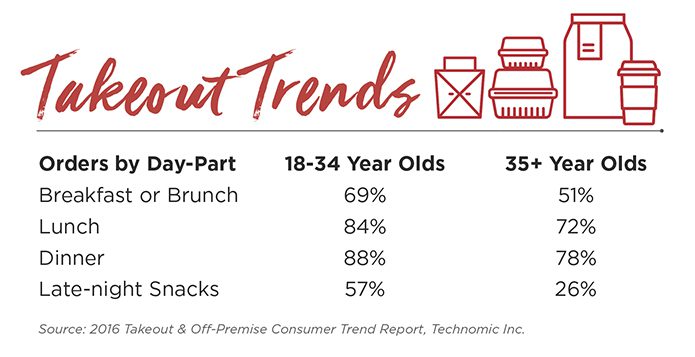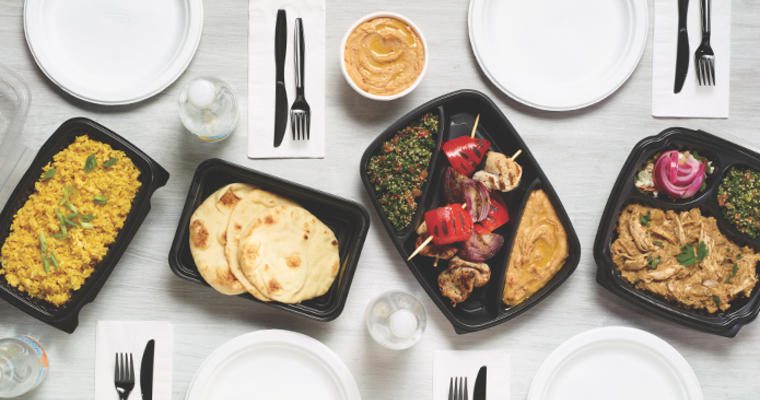More than ever before, consumers are looking at how portability allows them to access restaurant-quality dining experiences outside of a restaurant’s four walls, at places and times that are most convenient for them. Foodservice research firms Technomic and the NPD Group have identified a host of factors contributing to this behavioral shift—from more people working at home to the popularity of in-home video-streaming services to the proliferation of non-traditional prepared-food sources, such as grocery stores and meal delivery services.
This trend toward off-premise consumption is creating real opportunities for operators to grow their business in new and different ways—including delivery, takeout and grab-and-go-retail, all enabled by mobile technology.
In our Summer 2018 issue, we outlined the steps involved in adopting portability. Now we’re zeroing in on a make-or-break aspect of any portability program: packaging.

The wrong packaging can cancel out all the effort you put into creating a quality meal and deter repeat business, so it’s essential that you consider packaging options with great care. Here are a few guidelines to help you think it through.
1. Prioritize organizational brand integrity
Packaging considerations start with the items you offer for off-premise consumption. Maintaining the brand integrity of your organization is a critical factor in selecting those items.
Consumers have shifted—they expect the off-premise dining experience to be as close as possible, if not identical, to the experience of dining in your restaurant. Brand integrity is about making that happen. An off-premise offering that achieves brand integrity is characterized by:
- Products that support the organizational brand—for example, steak from a steakhouse or fish from a seafood restaurant.
- Packaging that meets consumer expectations for the brand—including look, feel and quality—and also ensures product integrity.
2. Evaluate items and ingredients
The biggest misconception about portability is that operators need to offer their entire restaurant menu for off-premise consumption. The fact is that your execution and customer service will likely be better with a reduced menu featuring products that maintain their integrity and hold time. Fewer items and faster execution improves the odds of customer satisfaction—and that will resonate in the competitive landscape far beyond an abundance of choices.
Start your evaluation by listing the key menu items and product ingredients that truly define your brand and separate you from competing food outlets—not just nearby restaurants, but also supermarkets, C-stores and meal-delivery services. This list is the foundation of your portability menu.
Now, some of the items on your list may travel better than others. Again, focus on the products that define your brand and make changes in ancillary items, if need be. Let’s say you can successfully offer a signature sandwich for off-premise dining, but the fries that come with it don’t really travel well. You may want to switch those out for a fry that is constructed to keep its integrity and hold time. There are more products than ever built for superior travel and hold, so it pays to review alternatives.
One caveat: remember that there is a distinction between your listed offering and the service you can provide. If a guest does request an item or ingredient from your “full menu” that you don’t make available for off-premise consumption, you don’t want to turn down the sale.
Instead, treat the request as “informative moment.” Tell the customer why you didn’t include that item on your portability menu and explain that your focus is on replicating the dine-in experience for off-premise consumers. This allows you to set the proper expectation for a customer ordering “off-menu.” It can also support an organizational brand that includes a commitment to guest service and transparency, which is highly valued by today’s consumers.
3. Let packaging form follow function
Packaging structure, transportability and reheating/cooking capabilities (if necessary) should always be taken into account first when evaluating your options. Aesthetics, branding and brand alignment with your environmental commitment are secondary.
Step 1: Function
Evaluate packaging for these factors:
- Keeps hot food hot
- Keeps cold food cold
- Humidity control
- Sealable
- Reheatable
- Microwaveable
- Overall food safety
Step 2: Form
This is about the look and feel of your packaging:
- Image alignment with your operation in terms of colors and design scheme
- Green characteristics—compostable, biodegradable, etc.
- Tamper-resistant
- Labeled/branded
To be clear, form and function are not mutually exclusive or even easily separated. This guideline is really about the sequence of importance—and the most important consideration is that the packaging ensures the food tastes good. The proper look and feel is secondary, but still critical.
4. Put costs in context
Operators will logically focus on the cost of packaging first. But letting cost dictate packaging decisions is a mistake in today’s environment. Savvy restaurateurs view packaging the same way they view the ambience of their physical operation—it is a tactile experience of the organizational brand. You should evaluate your packaging investment through the same lens as your investment in booths, carpets and lighting.
 Simply put, if the food is cold when it should be hot, if it has deconstructed in transport, if it simply no longer tastes good after leaving the restaurant—well, then, skimping on packaging has severely damaged customer perception of your brand. You won’t get any brownie points because your packaging costs less.
Simply put, if the food is cold when it should be hot, if it has deconstructed in transport, if it simply no longer tastes good after leaving the restaurant—well, then, skimping on packaging has severely damaged customer perception of your brand. You won’t get any brownie points because your packaging costs less.
Certainly, you need to weigh your packaging investment against your other costs. But remember that off-premise consumption doesn’t carry all the fixed costs associated with on-site consumption, nor does it incur the high variable costs of labor. It is important to look at this investment differently because off-premise sales potential is not limited by the boundaries of a physical location.
5. Ask the experts
Most operators are not well versed in the latest portability trends and technologies. That’s why it makes sense to have experts conduct a comprehensive evaluation of your menu and operation, with the aim of ensuring that your packaging will align with both your function and form.
For example, says Gordon Food Service® Non-Food and Product Beverage Specialist Kevin Brady, “If you’re concerned about the quality of plate presentation in your restaurant, you need to be concerned about it on your portable menu. How is the food going to look after it’s transported? Each meal ingredient has to be considered—you may need small, separate containers for sides and sauces to maintain a quality presentation.”
“Smaller packaging can also help with portion control, especially when it comes to snacks, a fast-growing delivery segment,” adds Gordon Food Service Non-Food Specialist Adriana Huff. “Using appropriately sized and shaped packaging saves you money—and it improves customer perception of your product. You don’t want to put three ounces of food in a seven-ounce container, or place a pie wedge in a square container. It just looks sloppy.”
Similarly, packaging that doesn’t match your brand experience looks careless. “A farm-to-fork restaurant probably doesn’t want to use industrial-looking packaging,” Brady advises. “If you’re a fine-dining restaurant, foam containers are probably not your best choice—and you certainly need to package your off-premise meals with high-quality utensils.”
Huff notes that customers often heat and reheat meals in their original containers. “Microwaveable meals require vented containers. This technology has really improved, so there are a lot more options to choose from.”
There are so many packaging options that people like Brady and Huff and our other Gordon Food Service experts can be invaluable in guiding you through your selection process.
Product experts can accelerate your decision-making process by narrowing down packaging options that support your product and your brand. They will also help you consider portability from a broader perspective that maximizes profitability.
6. Put your portability to the test
Brady recommends that operators order from their takeout and delivery menus—anonymously—on a random basis. “That’s the real test of your packaging. Especially if you’re using a third-party delivery company, you may be surprised at how the meal arrives at your door. And you may have to make some program adjustments.”
Consumer expectations for off-premise dining are rapidly evolving and the competition for off-premise dollars continues to accelerate. A winning packaging strategy can make all the difference. Now is the time to reevaluate your packaging through the lens of your brand and your investment in guest acquisition.
Decision Support
Contact your Sales Representative for expert advice on adopting portability, including packaging, culinary considerations and more.
Food Safety Resources
Off-premise dining can present unique food safety challenges. For additional information, including allergen information and printable takeout labels, sign in to gfs.com > click on Resources > Food Safety Awareness > Forms/Resources. For specific food safety questions, contact the Nutrition Resource Center by emailing nrc@gfs.com or calling (800) 968-4426.











